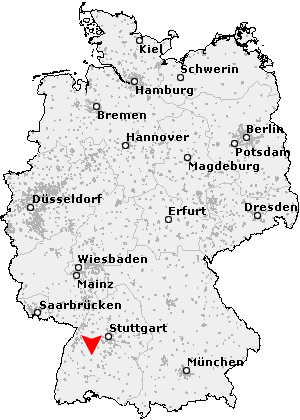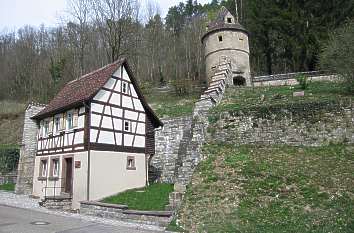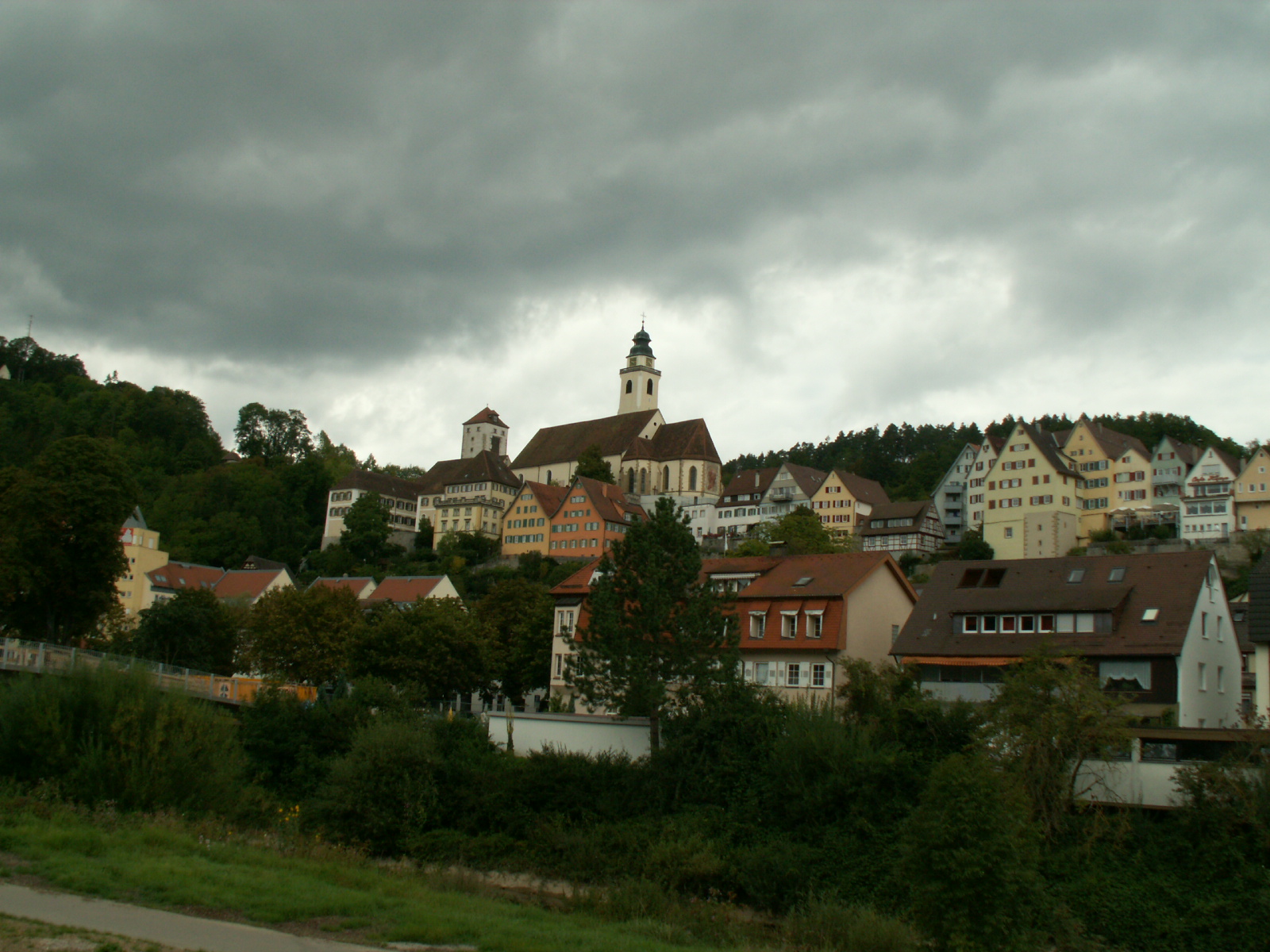Playing with the spellings of Schochenmaiers, I stumbled upon a woman with the name of Maria Schochenmeyerin who, being married to Michaele Dettling, got a baby Christoferus Dettling in 1676 in Altheim.
1. The forename of Michaele Dettling is written in a correct way, it's just a south dialectal form of the full name Michael that expresses any aspect of being "small". It might be read like Mikhele (compare with the Swiss Company name "Nestle" - small nest);
2. The spelling of Maria Schochenmeyerin corresponds to that of Sara Schachenmeyerin where I explained that "It's not a problem at all. In the Southern Germany until the 18th century (and in the Bavarian dialect till now!) the female family names got ending -in." So, we may conclude that father of Maria had had the surname of Schochenmeyer.
3. If Maria bore a child in 1676, she could be born between 1640s and 50s. After I thought of it, it caught my imagination. What if this is Maria Schochenmeyer daughter of Leopold Schochenmeyer from my posting on the oldest Schochenmaiers ever!!! Maria Schochenmeyer had been born in 1652 and thus she could get a baby in 1676 being just 24 years old at that time. There is a time coincidence but what about the spatial continuum?
4. The family of Maria (1652), namely Leopold Schochenmeyer and Anna Saueber had lived in Britzingen, it's South Baden near Freiburg, today on the border with France but at that time it was German Alsace (biggest towns are Straßburg and Mülhausen). The today's Maria had got her child (1676) in the catholic Altheim of the Schwarzwaldkreis within Württemberg. Where is it?
On Wikipedia you may find three different Altheims:
Altheim, Biberach, a municipality in the district of Biberach, Baden-Württemberg
Altheim (Alb), a municipality in the district of Alb-Donau, Baden-Württemberg
.png)
Altheim (Ehingen), a municipality in the district of Alb-Donau, Baden-Württemberg
All of them are not far from each other, but it's not Schwarzwald. Schwarzwald might be here:

On the net you may find a hole list of areas which made part of Schwarzwaldkreis:
Below are the Oberamt cities for the Schwarzwaldkreis area of Württemberg:
Oberamt Balingen
Oberamt Calw
Oberamt Freudenstadt
Oberamt Herrenberg
Oberamt Horb
Oberamt Nagold
Oberamt Neuenbürg
Oberamt Nürtingen
Oberamt Oberndorf
Oberamt Reutlingen
Oberamt Rottenburg
Oberamt Rottweil
Oberamt Spaichingen
Oberamt Sulz
Oberamt Tübingen
Oberamt Tuttlingen
Oberamt Urach
Under Oberamt Horb you may find the following:
So, we found out there there was another Altheim in Schwarzwald, that is a part of Horb today.
Horb am Neckar is a town in the southwest of the German state of Baden-Württemberg. It is located on the Neckar river, between Offenburg to the west (about 56 kilometres (35 mi) away) and Tübingen to the east (about 29 kilometres (18 mi) away).

In addition to the main town of Horb, the municipality includes a number of communities which are recognised within the terms of the 1970s Baden-Württemberg local government reform, that is they have an elected council and council chairman. These are Ahldorf, Altheim, Betra, Bildechingen, Bittelbronn, Dettensee, Dettingen, Dettlingen, Dießen, Grünmettstetten, Ihlingen, Isenburg, Mühlen, Mühringen, Nordstetten, Rexingen and Talheim, the last of which is made up of the formerly independent parishes of Obertalheim and Untertalheim. These are referred to formally (for example, in postal purposes) as Horb-Ahldorf, Horb-Altheim, etc.
The history of Horb is relatively boring because from 1381 to 1806 it belonged to Austria, and that's why it was officially Catholic:








It's only 120 km (75 miles) from Britzingen where she probably was born.


1. The forename of Michaele Dettling is written in a correct way, it's just a south dialectal form of the full name Michael that expresses any aspect of being "small". It might be read like Mikhele (compare with the Swiss Company name "Nestle" - small nest);
2. The spelling of Maria Schochenmeyerin corresponds to that of Sara Schachenmeyerin where I explained that "It's not a problem at all. In the Southern Germany until the 18th century (and in the Bavarian dialect till now!) the female family names got ending -in." So, we may conclude that father of Maria had had the surname of Schochenmeyer.
3. If Maria bore a child in 1676, she could be born between 1640s and 50s. After I thought of it, it caught my imagination. What if this is Maria Schochenmeyer daughter of Leopold Schochenmeyer from my posting on the oldest Schochenmaiers ever!!! Maria Schochenmeyer had been born in 1652 and thus she could get a baby in 1676 being just 24 years old at that time. There is a time coincidence but what about the spatial continuum?
4. The family of Maria (1652), namely Leopold Schochenmeyer and Anna Saueber had lived in Britzingen, it's South Baden near Freiburg, today on the border with France but at that time it was German Alsace (biggest towns are Straßburg and Mülhausen). The today's Maria had got her child (1676) in the catholic Altheim of the Schwarzwaldkreis within Württemberg. Where is it?
On Wikipedia you may find three different Altheims:

.png)

All of them are not far from each other, but it's not Schwarzwald. Schwarzwald might be here:

On the net you may find a hole list of areas which made part of Schwarzwaldkreis:
Below are the Oberamt cities for the Schwarzwaldkreis area of Württemberg:
Oberamt Balingen
Oberamt Calw
Oberamt Freudenstadt
Oberamt Herrenberg
Oberamt Horb
Oberamt Nagold
Oberamt Neuenbürg
Oberamt Nürtingen
Oberamt Oberndorf
Oberamt Reutlingen
Oberamt Rottenburg
Oberamt Rottweil
Oberamt Spaichingen
Oberamt Sulz
Oberamt Tübingen
Oberamt Tuttlingen
Oberamt Urach
Under Oberamt Horb you may find the following:
Parish Cities/towns for Oberamt Horb
.........
So, we found out there there was another Altheim in Schwarzwald, that is a part of Horb today.
Horb am Neckar is a town in the southwest of the German state of Baden-Württemberg. It is located on the Neckar river, between Offenburg to the west (about 56 kilometres (35 mi) away) and Tübingen to the east (about 29 kilometres (18 mi) away).

In addition to the main town of Horb, the municipality includes a number of communities which are recognised within the terms of the 1970s Baden-Württemberg local government reform, that is they have an elected council and council chairman. These are Ahldorf, Altheim, Betra, Bildechingen, Bittelbronn, Dettensee, Dettingen, Dettlingen, Dießen, Grünmettstetten, Ihlingen, Isenburg, Mühlen, Mühringen, Nordstetten, Rexingen and Talheim, the last of which is made up of the formerly independent parishes of Obertalheim and Untertalheim. These are referred to formally (for example, in postal purposes) as Horb-Ahldorf, Horb-Altheim, etc.
The history of Horb is relatively boring because from 1381 to 1806 it belonged to Austria, and that's why it was officially Catholic:
Further Austria or Anterior Austria (German: Vorderösterreich, formerly die Vorlande (pl.)) was the collective name for the early possessions of the House of Habsburg in the former Swabian stem duchy of south-western Germany, including territories in the Alsaceregion west of the Rhine and in Vorarlberg.
While the territories of Further Austria west of the Rhine and south of Lake Constance were gradually lost to France and the Swiss Confederacy, those in Swabia and Vorarlberg remained under Habsburg control until the Napoleonic Era.
Here is the Württemberg map of the 17th century. The Austrian territory is highlighted with brown:

Some pictures of Altheim in Horb:



The Catholic Church of St. Maria's Birth does exist till now. Who knows, maybe Maria Schochenmeyer christened their children here:



To go on foot will take 25 hours, thus it might be half day by carriage or 4-5 hours of horse riding. It seems pretty realistic. If it's true, then we have found the very first example of the Schochenmaier's relocation!!! It's not so far as Stuttgart and Heilbronn, but it's already a sort of trend ...
I should add that on November 1677 Maria will get another boy called Conrad:
but before those two boys she had got a girl Catharina Detling on the 29th March 1671:
So, she had two boys Conrad and Christofer who were Dettling as their father Michaele Dettling.
The surname distribution map proves that the highest rate of Dettling family name is precisely in Horb a.N.:

The bearers of this surname organized a real club dedicated to their genealogical research: http://www.dettling-familiengemeinschaft.de/index.shtml

I think I'll contact them, maybe they have any information on our Maria Schochenmeyer. We can't be sure that it's the same Maria from Britzingen but it's so suitable that can be true)))
Thanks for your attention and interest.




No comments:
Post a Comment